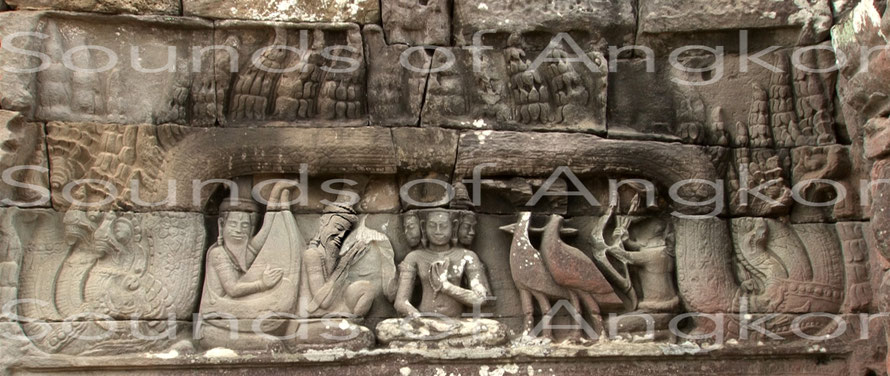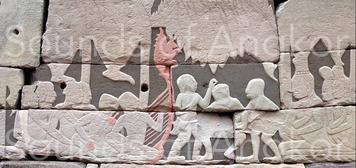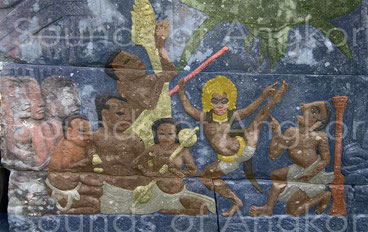Last update: December 5, 2023
The temple of Banteay Chhmar offers several representations of harps, some in the image of those at Bayon. Although the artists were different, the directives concerning the themes to be treated emanated from the same thought form, that of King Jayavarman VII. To date, 12 harps have been identified at Banteay Chhmar. Restoration of the historiated surrounding walls and the eastern gopura is still in progress, so there are still plenty of pleasant surprises in store.
For the record, the gallery of bas-reliefs is almost 538 metres long (on two levels), 223 metres longer than that of the Bayon (on three levels)!
Eastern gopura harps
Let's start with three exceptional depictions of harpists, on three lintels of the oriental gopura. A fourth lintel, still buried under a pile of stones, may one day reveal another. These three bearded musicians, with their eyes closed, wearing buns and earrings, are rishi.
Harpists of the Eastern gopura: from left to right, south, east and north lintels. Banteay Chhmar.
Interpreting the three lintels
To interpret the stories depicted on these three lintels, we will follow the work of Dr. Vittorio Roveda published in his book “Images of the gods”, which we will supplement with our own comments.
Southern lintel. The beheading of Shishupala
After Vittorio Roveda (Images of the gods).
"On a pediment of the eastern pavilion at Banteay Chhmar, the central figure is a rishi, seated in the usual cross-legged position. He holds a rosary, while his other arm extends towards a man on his left. He is wearing a triconic crown, earrings, a necklace, thin bracelets and crossed bands on his chest. His right arm is raised towards the rishi and appears to be holding a round object, a disc (?). His left hand is brandishing a sword, and it looks as if he has just cut off the head of a man with a cylindrical headdress or crown. The gesture is clean and precise; the severed head has fallen from its victim's body, earrings dangle, while the body remains seated, arms on chest and hands holding a small object or joined in prayer. To the left of the relief, a kneeling rishi holds the body of a child in his lap. On the far left, a rishi plays the harp (...). Krishna appears twice: as the rishi on the left, with the boy on his lap, and as the executioner prince on the right."
Our comments
On the right, Krishna is depicted with the attributes of King Jayavarman VII, builder of the Banteay Chhmar temple, i.e. the triconical crown, crossed harness and sword. The harpist's position is different from that of the other two. The raised instrument may be resting on a support that cannot be seen, as it is on the other side of the musician. There is no foot in front of the sounding board.
Eastern lintel. The origins of the Ramayana

Visual narratives from the Ramayana, Valmiki and Brahma (Book I, Balakanda, chapter 2). After Vittorio Roveda (Images of the gods).
"At the beginning of the Ramayana, in a sort of preamble, is the story of how the sage Valmiki came to compose his epic poem. One day, immediately after hearing Narada's short story about Rama's adventures, Valmiki was wandering with a disciple along a wooded bank, looking for a place to bathe. While he was admiring a mating of cranes, a hunter suddenly emerged from the trees and, with an arrow, killed the male, causing the female to weep desperately. The poet, full of compassion, spontaneously cursed the hunter... in metrical form. And so his emotional experience was transformed into poetic art. When Valmiki returned with his pupil to his ashrama, he received an unexpected visit from Brahma. While he honored the Creator's presence with appropriate worship, his mind continued to dwell on the tragic murder of the cranes. Brahma, aware of Valmiki's poetic gift, expressed the wish that Valmiki should continue to write poetry and retell the entire story of Rama, the Ramayana, for the enjoyment of mankind. Having made this proclamation, the god disappeared."
"Reading the relief from right to left, we see a man (tribal hunter) holding a bow and arrow having shot two cranes into his neck. He wears a hat whose top imitates the shape of a crane. At the center of the relief is Brahma with four heads and four arms, seated in yogic position. In early photographs (Marchal 1955: 123; Stern 1965, fig.188), he appears to be offering Valmiki a stylus with his upper right hand, while the lower part rests on his knees. His lower left arm is raised to his chest with a rosary, but its upper part is hidden. To Brahma's left is a kneeling figure who appears to be holding a palm-leaf manuscript in his right arm - Valmiki holding a page of his poem! (...) Further to the left is the same harp player who appears in two adjacent pediments. Does he represent the singing of the story or the music played to accompany his narration? Was he a minstrel? If so, this relief would represent a story told by a different narrator."
Our comments
This scene thus seems to describe the initiatory episode of the birth of the written text of the Ramayana, which Khmers have known since pre-Angkorian times as the Reamker (រាមកេរ្តិ៍).
The harp played by this rishi is singular: the base of the neck is penta- or hexagonal and two wings seem to spread out. It is the only one in this style among all Angkorian representations. Given that the harp is associated with the bird, perhaps the body, wings and neck of the bird in Valmiki's story are explicitly represented. As for the position of the left hand resting on the top of the neck, perhaps it refers to the head and beak of the deceased bird? The harp and this hand are mirrored in relation to the two birds on the right. Note also that the string plane is not straight but curved, which could mean that the harp cannot sound, as the strings are distended by the tension exerted by the musician's hand on the neck. Perhaps this symbolizes the death of the crane, which has also fallen silent... Or perhaps it's a playing technique designed to lower the note by a certain amount to create an ornament or vibrato. Such a position can also be seen on a harp isolated from a volute decoration in the North tower-sanctuary BY.20 on the third floor of the Bayon.
Organological detail: note the "button" on the back of the soundbox and the shoulder strap passing over the musician's back and left shoulder. Despite the quality of the carving and the attention to detail, the harp has no visible foot in front of the soundbox. The musician plays with the instrument resting on his right thigh.
Northern lintel. Shiva and Kama
After Vittorio Roveda (Images of the gods).
"I think it's possible to interpret this scene as a representation of the Kama-Shiva confrontation. In the center, Shiva is seated, legs crossed, holding the rosary and trishula. On the right is Parvati, her hand raised, a gesture repeated by the crowned male figure on the left, whose face has animal features (large mouth, pointed ears). He could be the human aspect of Nandi or represent the guardian of Shiva's abode. Further left, a rishi plays (...) a harp. On the far right, a crowned, kneeling man points his bow at the god. While certain elements of the scene are reminiscent of the myth, its simplicity and layout raise doubts about my interpretation."
Our comments
The harp rests on the musician's right thigh. A foot is visible in front of the soundbox.
Eastern gallery harps
Buffoonery scene 1 (?)

In this buffoonery (?) scene from the east gallery, the orchestra consists of a harp, a double-resonator zither and a pair of cymbals. The same ingredients are used as in a scene from the Bayon (south gallery, east wing), with the musicians positioned in the same way. There are, however, two dancers around the jester.
Buffoonery scene 2 (?)
Bien que les harpes à tête de Garuda aient été traitées dans un chapitre spécifique, nous rappelons ici le temple de Banteay Chhmar offrent deux occurrences de harpes dont les extrémités sommitales sont figuratives. Dans deux cas, on peut voir, derrière le harpiste et sous la protection du Garuda, un personnage — bouffon ou barde (?) — qui semble défier le roi ou les dieux.
Although Garuda head harps have been dealt with in a separate chapter, the Banteay Chhmar temple offers two examples of harps with figurative ends. In both cases, behind the harpist and under the protection of the Garuda, we can see a character - jester or bard (?) - who seems to be challenging the king or the gods.

This orchestra consists of a harp, a double-resonator monochord zither, cymbalettes and a singer. The top of the harp appears to be adorned with a horse's breast, head and leg, which seems impossible given other known occurrences in similar situations. For the moment, only the image of a Garuda head seems plausible.
Western gallery harps
During our last visit in December 2020, four new harps were discovered following the reassembly of the west wall.
Religious orchestra

Ce bas-relief à caractère musical est l'un des plus beaux de toute l'iconographie khmère de l'époque du Bayon. This musical bas-relief is one of the finest in Khmer iconography from the Bayon period. It shows a 22-armed Avalokiteshvara surrounded by apsaras wearing jasmine garlands in the upper register and orants in the middle registers. He is also surrounded by ten medallions, in the middle of which are other apsaras wearing jasmine garlands, seated in an unusual position. In the lower register, one or two orchestras on either side of the lotiform pedestal. Various elements support one or the other hypothesis: one or two orchestras.
> An orchestra: only one female singer and doctor blade player is visible on the left.
The orchestra would then have no female singer.
> Two orchestras: the ensemble on the right features two harps and two harpists depicted in perspective.In total, the two orchestras feature three zithers, which would be a first in the canon of Bayon period representations.
This bas-relief is also the only occasion on which we've seen this front bun worn by a musician/singer. In all other cases, female singers are shown in profile. On the other hand, such a bun seen from the front is common among the said devatas in the shrines of the Jayavaman VII period. The present case may support our theory about female shrine praise singers. See our page on voice. The harp on the left appears to be played by a man and that on the right by a woman. This is a rare example of a mixed orchestra, although we know from the Lolei inscriptions (9th c.) that women's orchestras included male percussionists.
Palatine Orchestra
This eroded scene is in the upper register (third). The female orchestra is composed of (L. to R.): a singer, recognizable by her double bun and outstretched index finger, a dancer holding a jasmine garland, a harpist, a zither player whose instrument is no longer visible, but the musician's position is characteristic. To the right of the orchestra, standing, perhaps a princess. On the left, seated, a king or prince. Note the pillars, roof and attached curtains.
Processional orchestra
This orchestra has the same ingredients as the two orchestras in the east gallery, south wing, of the Bayon, with the difference that it is in the first register. Several instruments and players can be distinguished, from L. to R.: a double-resonator zither, a singer, identifiable by his open mouth, a scraper, cymbals linked by a cord, a harp. From the citharist's perspective, the character could be his double (uncut); likewise for the harpist (but without the harp).
Broken harp 1
The reassembly of this part of the wall is inconsistent. Above the harp, the two female figures do not connect. The harp and the harpist's hand, however, are beautifully crafted. There are some fifteen well-sculpted strings, but this number cannot be taken as a real clue. The tailpiece is materialized. The context is incomprehensible.
Broken harp 2
Many stones were missing to rebuild this portion of the wall. A harpist is clearly visible, with a singer behind her, whose status is indicated only by her curly bun. In front of the harp, a figure with an indeterminate role.
Broken harp 3
This damaged scene is musically minimalist. We can see a dancer accompanied by a harp. It appears to be a man seen from the back, as in the "religious orchestra" shown above. Of the harp, only part of the sound box and the string plane are visible. From the harpist's perspective, the face is that of another musician.
Northern gallery harp
The northern gallery is only partial. Perhaps there are other harps among the piles of stones. Time will tell.
Buffoonery scene (?)
This orchestra is made up of three instruments: harp, double-resonator monochord zither and cymbals. The top of the harp is eroded. However, given its overall shape and multiple occurrences at Bayon and the Terrace of the Elephants, there is little doubt that it is a Garuda head.
During our last visit in December 2020, this scene was barely visible, as it was covered in blackish particles. Future restoration work in the north gallery should restore it to its former glory.

























